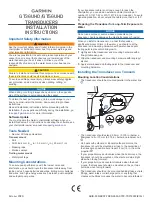
TXP-WTA_Instruction_Manual_(Rev1.3)
REV – 1.3
[34-2900-0207-4 ]
25
|
P a g e
Figure 6-3 – Cal-Mode Flow Chart and Menus
6.3
Alarm Operation
All alarm decision making is done by the TXP-WTA Sensor Transmitter with the results broadcast to the controller
and/or wireless relay. TXP-WTA Sensor Transmitters have five front panel LEDs to indicate: Alarm 1, Alarm 2 and
Alarm 3, FAIL and COM (communication).
•
Alarm LEDs only flash during alarm events to conserve battery life.
•
Low Battery is indicated by an icon on the LCD and by flashing the FAIL LED.
•
ONLY LEVEL ALARMS (A1, A2, A3) INCREASE WIRELESS BROADCASTS TO EVERY 6 SECONDS!
•
Alarms may be set to trip upon increasing and decreasing readings (see Section 7.3.3).
6.3.1
Understanding Fail Alarm Operation
The FAIL alarm indicates system related problems, such as:
•
missing sensor
•
sensor failures
•
inability to synchronize to the Server, and excessive negative readings
The Fault Alarm Menu described in Section 7.3 allows setting how far below zero (negative) the reading may fall
prior to tripping the FAIL alarm.
CAUTION
: MISSING OR FAILED SENSORS ALWAYS TRIP THE FAIL ALARM. FAIL ALARM CONDITIONS DO NOT CAUSE
THE RADIO BROADCAST RATE TO INCREASE TO 6 SECONDS.
6.3.2
Low Battery Condition
The nominal battery voltage is 3.6 volts.
TXP-WTA Sensor Transmitters trip their Low Batt alarm at < 3.3 volts. This causes the Low Batt icon to appear in the
upper left corner of the display and the Fail LED to flash.
At 3.2 volts, the TXP-WTA Sensor Transmitter enters the Replace Battery mode.
In Replace Battery mode:
















































